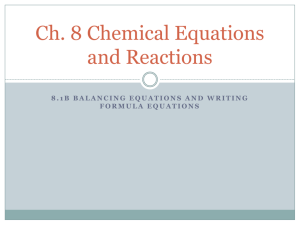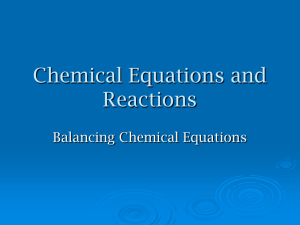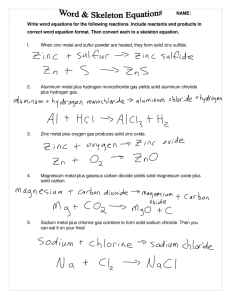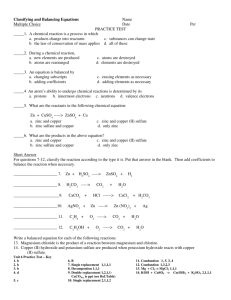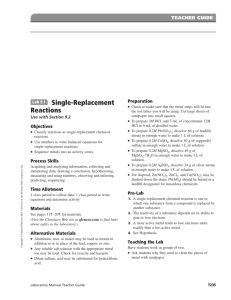Starter 2/6
advertisement
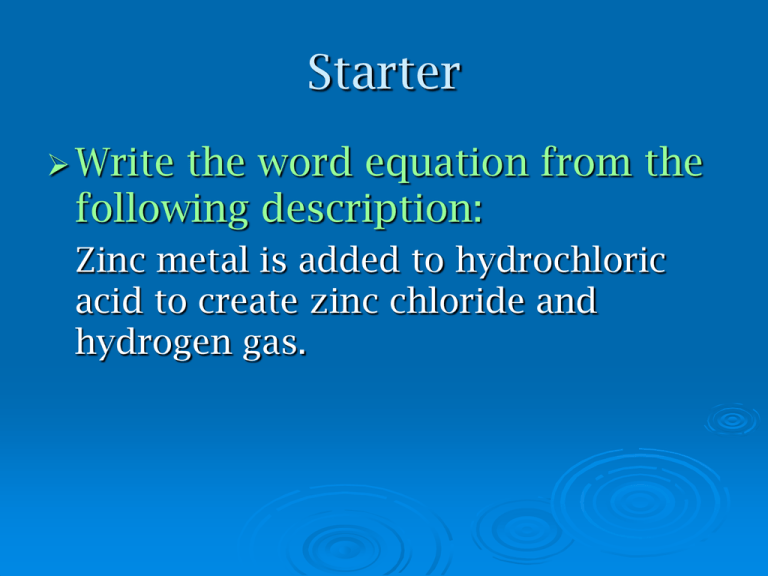
Starter Write the word equation from the following description: Zinc metal is added to hydrochloric acid to create zinc chloride and hydrogen gas. Ch. 8 Chemical Equations and Reactions 8.1b Balancing Equations and Writing Formula Equations Balancing Equations 1. 2. 3. 4. 5. 6. ONLY add/change coefficientsNEVER subscripts!!! balance one type of atom at a time balance polyatomic ions first balance atoms that appear only once second balance H and O last simplify if you can Check at end! Writing Equations Write Word equations to help you organize reactants and products Be sure to include symbols showing states of each reactant and product Be sure to write the correct formula for each (crossing over for ionic compounds!) Check your balancing of the equation when you are finished Example 1 Description: Zinc metal is added to hydrochloric acid to create zinc chloride and hydrogen gas. Word Equation: zinc + hydrochloric acid zinc chloride + hydrogen Example 1 Formula Equation: Zn (s) + HCl(aq) ZnCl2(aq) + H2(g) Balanced Formula Equation Zn (s) + 2HCl(aq) ZnCl2(aq) + H2(g) Example 2 Solid calcium metal reacts with water to form aqueous calcium hydroxide and hydrogen gas. calcium + water calcium hydroxide + hydrogen Ca(s) + H2O(l) Ca(OH)2(aq) + H2(g) Ca(s) + 2H2O(l) Ca(OH)2(aq) + H2(g) Example 3 solid zinc metal reacts with aqueous copper (II) sulfate to produce solid copper metal and aqueous zinc sulfate zinc + copper (II) sulfate copper + zinc sulfate Zn(s) + CuSO4(aq) Cu(s) + ZnSO4(aq) Zn(s) + CuSO4(aq) Cu(s) + ZnSO4(aq) Example 4 Hydrogen peroxide in an aqueous solution decomposes to produce oxygen and water hydrogen peroxide oxygen + water H2O2(aq) O2(g) + H2O(l) 2H2O2(aq) O2(g) + 2H2O(l) Example 5 Solid copper metal reacts with aqueous silver nitrate to produce solid silver metal and aqueous copper (II) nitrate copper + silver nitrate silver + copper (II) nitrate Cu(s) + AgNO3(aq) Ag(s) + Cu(NO3)2(aq) Cu(s) + 2AgNO3(aq) 2Ag(s) + Cu(NO3)2(aq) Example 6 Carbon dioxide gas is bubbled through water containing solid barium carbonate, creating aqueous barium bicarbonate carbon dioxide + water + barium carbonate barium bicarbonate CO2(g) + H2O(l) + BaCO3(s) Ba(HCO3)2(aq) CO2(g) + H2O(l) + BaCO3(s) Ba(HCO3)2(aq) Example 7 Acetic acid solution is added to a solution of magnesium bicarbonate to create water, carbon dioxide gas, and aqueous magnesium acetate. acetic acid + magnesium bicarbonate water + carbon dioxide + magnesium acetate HCH3COO(aq) + Mg(HCO3)2(aq) H2O(l) + CO2(g) + Mg(CH3COO)2(aq) 2HCH3COO(aq) + Mg(HCO3)2(aq) 2H2O(l) + 2CO2(g) + Mg(CH3COO)2(aq)
